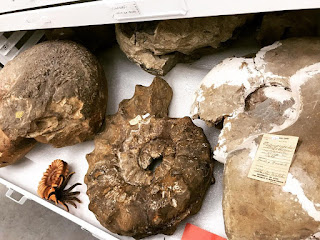Houston Museum of Natural Science
Thanksgiving with family in Texas means a trip to the Houston Museum of Natural Science.
I love natural history museums. LOVE them. I grew up in Wisconsin, and every few months we would make a weekend trip to Chicago to visit the Field Museum, along with its neighbors, the Shedd Aquarium and the Adler Planetarium.
The current star resident of the Field is SUE™, a very large and very complete Tyrannosaurus rex skeleton. (And very expensive; Disney and McDonald’s helped the Field buy the specimen to keep it accessible to the public and to scientific researchers, rather than allowing it to disappear into a private collection.) When I was a kid, the Field was in pre-SUE days, but I still adored the museum—the gems and minerals, the dioramas of taxidermied mounts, the soaring foyer like a cathedral.
When/if I can ever retire, I want to spend my retirement traveling the world, visiting natural history museums.
The paleontology section of HMNS is arranged chronologically by geographic era. I like that; it appeals to my sense of organization. So you start with very early life in the form of stromatolites, footstool-shaped structures created by blue-green algae. Then to the Cambrian with a really phenomenal collection of trilobites (~500 million years ago), then to the Permian, when the world was populated by weird synapsids—ancestors of mammals—like sail-backed Dimetrodon and saber-tooth gorgons. The Permian ended with a mass extinction bigger than the mass extinction that killed the dinosaurs: 90-95% of terrestrial and marine species vanished. Then the exhibit moves on to marine reptiles, dinosaurs, pterosaurs, and then to the Cenozoic (modern era). Someday, I need to go spend a day at the museum by myself. My family left me behind in the Permian.
 |
This trilobite's eyes are pyritized: replaced by pyrite (fool's gold). Isn't that cool?
|
 |
Trilobites
|
 |
| Dimetrodon - Not a Dinosaur! |
 |
| Saber-tooth gorgon, from way before the time of dinosaurs. |
 |
Petrified wood, geologist for scale.
|
 |
Humungous crinoid, teenager for scale.
|
 |
"Wyrex" the bobtail T. rex. Someone chomped off the back half of his tail. The bones do not show signs of healing, so the wound may have been fatal. (Certainly there would have been a lot of hemorrhage from a traumatic amputation of that hugely muscular tail!)
|
 |
Quetzalcoatlus had a 35-foot wingspan!
|
Near the main entrance is the Curator’s Choice, which features some of the recent acquisitions. The museum acquires 3,000-5,000 items every year for research or future exhibitions. Cool objects include birds carved from sperm whale teeth, and a fossilized Jurassic jellyfish.
A special exhibit at the museum is called Death By Natural Causes, which features all the exciting ways that nature wants to kill you, including toxic minerals, venomous animals, poisonous plants and fungi, epidemics, and attacks by large angry creatures.
 |
Hippopotamuses can kill you. Look at those teeth! (Behind the hippo is an armadillo; they kill you by transmitting leprosy.)
|
 |
Uranium glass under UV light
|
 |
Deadly pigments
|
 |
This dress is gorgeous but the green dye is copper arsenite, which could give the wearer arsenic poisoning.
|
 |
Snakebite mechanics
|
Another area of the museum is put together to replicate the Cabinet of Curiosity that Ferrante Imperato assembled in 1599; Cabinets of Curiosity were eclectically jumbled assortments of natural history specimens collected by wealthy European travelers.
And so much more!
 |
Shells!
|
 |
| Rocks and minerals! |
 |
A giant squid model!
|
 |
Live butterflies!
|


























